Five Tips to Help You Breathe Easier With Allergies…
Five Tips to Help You Breathe Easier With Allergies…
There’s a lot we love about spring. And then, there’s a lot we don’t—particularly if we suffer from asthma or allergies. Just look outside and you can see why. Pollen covers our cars, is layered on our windows, and can even be seen in the air. And for people suffering from seasonal allergies or asthma, these large quantities of pollen call for much more than a car wash.
There’s a lot we love about spring. And then, there’s a lot we don’t—particularly if we suffer from asthma or allergies. Just look outside and you can see why. Pollen covers our cars, is layered on our windows, and can even be seen in the air. And for people suffering from seasonal allergies or asthma, these large quantities of pollen call for much more than a car wash.
Asthma and allergies are two of the most common conditions in the U.S. According to the CDC:
- About 25 million Americans have asthma (20 million adults and 5 million children).
- About 32 million Americans have food allergies (26 million adults and 6 million children).
- About 24 million Americans have rhinitis (hay fever), or nasal allergies (19.2 million adults and 5.2 million children).
If left untreated, allergies and asthma can lead to infection, hospitalization, and even death. Seeking treatment and learning to manage symptoms is crucial for maintaining health all year long. And one of the best ways to manage symptoms is to be proactive. To that end, we’ve compiled some tips to help you get ahead of those sneezes.
Five Tips to Beat Allergy Season
1. Know your Triggers
The first step in learning to manage your allergies is understanding what causes them. Seasonal allergies largely come from outdoor triggers. This means allergies are based on where you live, as different areas of the country are prone to different allergens. Learning what allergens may be affecting you in your area will allow you to better prepare for allergy season.
Most people think they know what is causing their allergies. But thinking is not the same as getting tested and knowing for sure. With so much at stake, this isn’t a time for guesswork. Know without a doubt what is causing your symptoms, so you can work on reducing exposure to them.
2. Don’t Wait for that First Sneeze
By the time you’re sneezing, your allergies have clearly already set in. You don’t have to wait though. Getting started with your allergy management early (before you “need it”) can significantly improve your enjoyment of these months. When it comes to allergies, preventative care is always best.
3. De-allergen your Home
It’s called spring cleaning for a reason! Allergens can easily find their way into your home through open windows and doors and even on your clothing and shoes. Keeping up with regular cleaning and air filter replacement will prevent allergens from sticking around indoors. You can also decrease the number of allergens brought into your home by changing your clothing after being outside.
4. Experiment
Allergy relief has a collection of helpful tricks. Take some time to find what others recommend and try them yourself to see what offers you the most relief. Common home remedies, such as nasal rinsing, steaming, and herbal teas/vitamins are often very effective.
5. Take your Medication Daily
Many allergy medications are most effective with daily use. However, most people only use them when they feel like they absolutely need them. Starting early and consistently using allergy medication will offer you the best results in managing them.
While there are no cures for allergies and asthma, they can be managed effectively with the five tips mentioned above and by using the right products. Remember, a better connection to the clean air you breathe is a better connection to the world around you. For more information about clean air benefits, please schedule a call. I’d be happy to help guide you along your wellness path.










